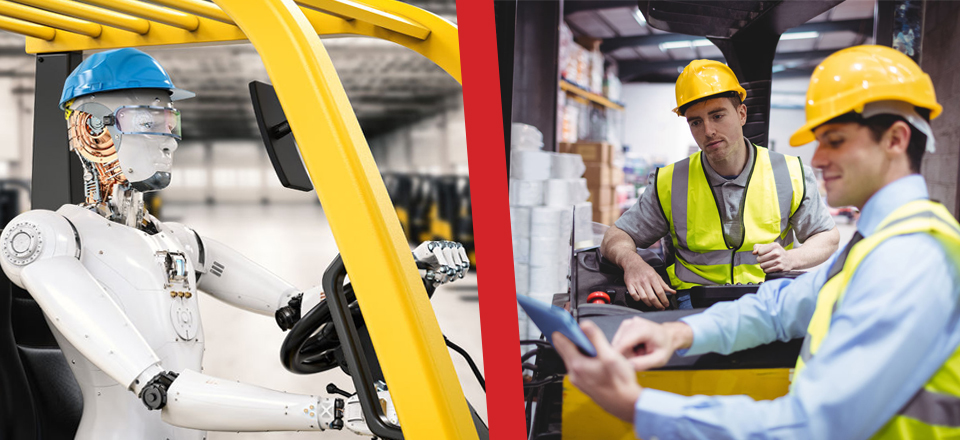If you’ve been studying supply chain management or involved in it for any length of time, you’ll know that it’s almost impossible to run a modern supply chain without the use of technological systems and solutions.
You’ll also be aware that some of those systems and solutions, while often demanding significant investment, are becoming increasingly desirable as the cost of labour continues to rise.
But is it really a straightforward equation? Do technology implementations always reduce labour costs, and if so, are there tradeoffs that must be accepted when choosing whether to take the technological high ground in supply chain operations?
The Answer is Yes… And Yes
Assuming that a company implements technology with the objective of reducing labour costs, and that it selects the right solutions to achieve that goal, the outcome is almost certain to involve some degree of labour-cost saving.
That doesn’t mean that replacing labour with technology is always the best solution though. In many cases it will be, but there are almost always some tradeoffs to evaluate in making the decision.
On the other hand, situations will always exist (and as technology advances, increasingly so) in which manual operations place your company at a substantial disadvantage against competitors.
The tradeoffs and their importance are not always obvious, and they certainly won’t apply to the same extent in every supply chain operation. However, it’s worth taking a little time to understand what they might comprise, in case you’re ever involved in a decision pitting the value of manual labour against that of a technology investment.
There’s More to Labour Cost than Meets the Eye
Many executive teams stall or delay the decision to implement new technology because of the big, up-front investment that’s often required. Instead, they choose to continue with manual operations under the assertion that at least they understand their current costs—but do they really?
The direct costs involved with manual labor are of course, calculable. There’s the cost of wages for basic hours and overtime, the cost of employee benefits, perhaps also the cost of clothing or other ancillary items. Aside from these though, there are other costs less easy to quantify, and notoriously difficult to control.
If your company chooses manual labour over an appropriate technological solution, it should do so with a full appreciation of those costs, which might include:
- Employee turnover costs
- Costs of human error (rework, inventory damage or losses)
- Costs of workplace incidents/accidents
- Costs of covering absent employees (holidays and sickness for example)
- Training costs (and costs of low productivity during training)
- Variable costs associated with worker productivity (every poor performer increases the cost of labour)
These are just a few examples of costs that technology investment might ultimately reduce, along with the more obvious and quantifiable costs of labour employment.
There are other potential cost tradeoffs too. For example, by choosing not to implement automation, your company could be robbing itself of savings that might be made by improved efficiency. These could include for example, the cost of inventory holdings which with automation in place, could be reduced to a lower level.
Possible Tradeoffs in Technology Deployment
As already mentioned, there are tradeoffs to be made in choosing technology too. In order to reduce labour costs through technology for example, your company would need to spend a considerable amount of money to implement a particular solution. In the case of warehouse automation or even a good ERP platform, capital investment could easily run to a six-figure sum.
Unless you’re investing in an automated solution that will all but eliminate manual labour, you will still have some people involved in your operation. If those people should use the solution, you may have to spend some money for them to do so.
Certainly there will be training costs to take into account and if your solution is some form of IT platform, you will also need to shoulder licensing costs, which can be pretty hefty.
Perhaps though, your solutions will eliminate most of the manual labour, such as the construction of an automated warehouse. Before you sanction investment in such a venture though, remember to check employment legislation in your country. Removing headcount from your workforce can be an expensive exercise.
Don’t Forget the Cost of Keeping Up
Another thing to bear in mind is the pace at which technology is moving today. While manual operations must bear the cost of training to keep the workforce abreast of changing industry and business requirements, technology solutions must be updated too from time to time.
If your multi-million dollar process-automation solution is overtaken by superior technology, you’ll be faced with the costs of upgrading what you have, or perhaps even replacing it to stay competitive.
After all, standing still is going backward in the supply chain environment, and once automation has been adopted, your company is certainly not going to go back to an operation dependent on manual processes.
Minimise Tradeoffs Where Possible
Hopefully this article has helped you to understand that the technology versus labour cost debate is never totally black and white, and that tradeoffs must be taken into consideration. However, that does not have to mean you simply accept them.
When applying technology as an antidote to ever-increasing supply chain labour costs, there’s often a sweet spot you can aim for.
To hit it you must first evaluate the cost tradeoffs, and then identify which of them must be accepted. It’s often possible to minimise some tradeoffs—or better still—eliminate them entirely with the right choice of solution and strategy. That’s not to say the task is easy, but if you know what tradeoffs exist in the first place and can analyse and plan accordingly, it’s certainly not impossible.

Best Regards,
Rob O’Byrne
Email: robyrne@logisticsbureau.com
Phone: +61 417 417 307

